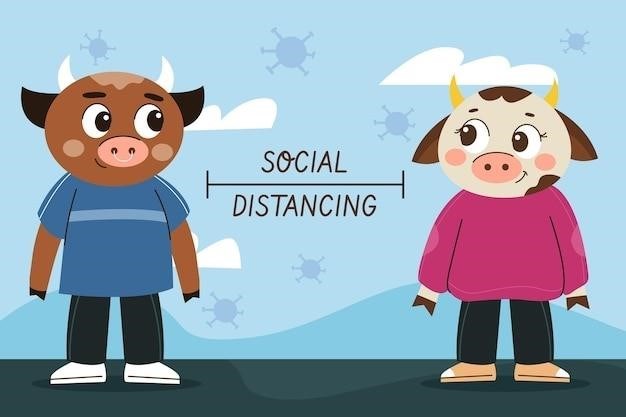La culpa es de la vaca⁚ Exploring Themes of Responsibility and Change
This book explores the themes of responsibility and change through a collection of anecdotes‚ fables‚ and parables that share a common thread⁚ the need for adaptation․ The book emphasizes the importance of accepting change‚ taking responsibility for our actions‚ and fostering a culture of humility and tolerance․ It uses the phrase “la culpa es de la vaca” (the cow is to blame) as a metaphor for how we often shift blame onto others instead of taking responsibility for our own mistakes․ It is a thought-provoking read that encourages us to be more mindful of our own actions and the need to adapt to a changing world․
A Collection of Stories and Reflections
The book “La culpa es de la vaca” is a captivating journey through a diverse tapestry of stories and reflections‚ each weaving a unique thread into the overarching narrative of responsibility and change․ It invites readers to delve into a world where anecdotes‚ fables‚ and parables converge‚ offering a fresh perspective on the complexities of human nature․ The authors skillfully craft these narratives‚ drawing upon diverse cultural influences to illustrate universal themes that resonate with readers of all backgrounds․
Each story serves as a microcosm of the broader message‚ prompting introspection and encouraging readers to engage in critical self-reflection․ These narratives act as mirrors‚ reflecting back the common human tendency to deflect blame and shift responsibility onto others․ Through these poignant tales‚ the authors skillfully illuminate the importance of embracing change‚ fostering humility‚ and fostering a culture of tolerance․ Ultimately‚ “La culpa es de la vaca” is a compelling invitation to embrace the power of storytelling as a catalyst for personal growth and societal transformation․

The Power of Storytelling
At the heart of “La culpa es de la vaca” lies the profound power of storytelling․ The authors‚ Jaime Lopera and Marta Inés Bernal‚ recognize the inherent ability of narratives to transcend language barriers and connect with readers on a deeply personal level․ They skillfully weave together anecdotes‚ fables‚ and parables‚ drawing upon a rich tapestry of cultural influences to create a compelling and thought-provoking tapestry․
These stories serve as powerful vehicles for conveying complex ideas about responsibility‚ change‚ and the human condition․ The authors masterfully use the art of storytelling to illuminate universal truths‚ challenging readers to confront their own biases and embrace the transformative power of introspection․ Through these engaging narratives‚ “La culpa es de la vaca” underscores the importance of storytelling as a catalyst for personal growth‚ societal change‚ and the fostering of a more compassionate and understanding world․
Themes of Change and Adaptation
The book “La culpa es de la vaca” explores the inevitable nature of change and the importance of adapting to new circumstances․ It delves into the complexities of navigating a world in constant flux‚ emphasizing the need for flexibility‚ resilience‚ and a willingness to embrace the unknown․ The authors skillfully weave together anecdotes‚ fables‚ and parables‚ each offering a unique perspective on the challenges and opportunities presented by change․
Through these diverse narratives‚ the book underscores the need for a proactive approach to adaptation‚ encouraging readers to step outside their comfort zones and embrace new perspectives․ It highlights the dangers of clinging to outdated paradigms‚ emphasizing the importance of staying informed‚ agile‚ and open to new ideas․ By exploring the theme of change through a collection of engaging and insightful stories‚ “La culpa es de la vaca” serves as a potent reminder that adaptability is not just a skill but a crucial aspect of thriving in a constantly evolving world․
The Need for Humility and Tolerance
The book “La culpa es de la vaca” delves into the significance of humility and tolerance as essential qualities for navigating a complex and ever-changing world․ It underscores the dangers of arrogance and self-righteousness‚ highlighting how these traits can lead to misunderstandings‚ conflict‚ and a lack of progress․
Through a series of anecdotes and parables‚ the book emphasizes the importance of approaching others with empathy and understanding‚ recognizing the value of diverse perspectives and experiences․ It encourages readers to cultivate a sense of humility‚ acknowledging their own limitations and the inherent complexity of the world around them․ By fostering tolerance and open-mindedness‚ the book suggests‚ we can create a more inclusive and harmonious society where individuals can learn from each other and work together to create positive change․
The Role of Leadership
The book “La culpa es de la vaca” explores the role of leadership in fostering a culture of responsibility and change․ It emphasizes that effective leadership involves more than just issuing commands or dictating solutions․ Instead‚ it calls for leaders who are willing to listen‚ learn‚ and adapt to the evolving needs of their followers and the changing world around them․
The book suggests that true leadership is characterized by humility‚ empathy‚ and a commitment to promoting collaboration and shared understanding․ Leaders who embody these qualities are more likely to inspire trust‚ encourage participation‚ and empower others to take ownership of their roles in creating positive change․ By fostering a sense of shared responsibility and encouraging open dialogue‚ leaders can create an environment where individuals feel valued‚ heard‚ and empowered to contribute to the collective good․
The Importance of Taking Responsibility
One of the central themes explored in “La culpa es de la vaca” is the importance of taking responsibility for our actions․ The book uses the phrase “la culpa es de la vaca” as a metaphor for the human tendency to shift blame onto others instead of acknowledging our own mistakes․ It highlights how this tendency can hinder personal growth‚ prevent meaningful change‚ and damage relationships․
The book emphasizes that taking responsibility is not about self-flagellation but about acknowledging our role in events‚ learning from our mistakes‚ and making amends when necessary․ It encourages readers to confront their own shortcomings‚ to be accountable for their actions‚ and to strive for continuous improvement․ Taking responsibility is not a sign of weakness‚ but a sign of strength‚ courage‚ and commitment to personal and collective growth․
The Blame Game⁚ A Common Human Tendency
The book “La culpa es de la vaca” delves into the human tendency to engage in the blame game‚ often seeking external factors or scapegoats to explain our failures and shortcomings․ This tendency‚ as the book highlights‚ is deeply ingrained in human nature‚ often stemming from a desire to protect our ego‚ avoid responsibility‚ and maintain a sense of control․ This blame game can manifest in various ways‚ from blaming others for our mistakes to attributing our misfortunes to external factors beyond our control․
The book presents anecdotes and parables that illustrate the consequences of this blame-shifting behavior․ It shows how the blame game can lead to conflict‚ hinder communication‚ and prevent meaningful solutions․ It encourages readers to recognize this tendency in themselves and in others‚ and to consciously choose to break free from the cycle of blame‚ fostering a more constructive and empathetic approach to dealing with challenges and setbacks․

Exploring the Nature of Guilt and Blame
The book “La culpa es de la vaca” delves into the complex interplay of guilt and blame‚ exploring how these emotions shape our perceptions and influence our behavior․ It delves into the nature of guilt‚ examining how it arises from a sense of wrongdoing‚ a violation of personal or societal norms․ The book explores how guilt can motivate us to seek atonement‚ to make amends for our actions‚ and to strive for redemption․ However‚ it also acknowledges the potential for guilt to become overwhelming‚ leading to self-punishment‚ shame‚ and a sense of worthlessness․
The book contrasts guilt with blame‚ highlighting how blame is often directed outwards‚ assigning responsibility for our misfortunes to others․ It examines how blame can be a form of defense mechanism‚ allowing us to deflect responsibility and maintain a sense of innocence․ However‚ the book cautions against the dangers of excessive blame‚ emphasizing how it can lead to resentment‚ conflict‚ and a breakdown in communication․ It encourages readers to cultivate a more nuanced understanding of guilt and blame‚ recognizing their complexities and learning to navigate these emotions with greater awareness and compassion․
The Cow is to Blame⁚ A Symbol of Shifting Responsibility
The titular phrase “La culpa es de la vaca” (The cow is to blame) serves as a powerful metaphor throughout the book‚ encapsulating a common human tendency to deflect responsibility․ It highlights how we often seek scapegoats for our failures‚ blaming external factors or individuals rather than taking ownership of our own shortcomings․ This tendency is explored through a series of anecdotes and stories‚ demonstrating how the “cow” can represent anything from a faulty product to a difficult colleague or even an unfavorable economic climate․ The book encourages readers to examine their own tendency to shift blame‚ urging them to consider the role they play in their own successes and failures․
By using the image of the cow‚ the book invites readers to reflect on the absurdity of placing blame on an innocent animal․ It suggests that seeking external scapegoats often stems from a desire to avoid confronting uncomfortable truths about ourselves and our own choices․ The book ultimately aims to challenge this pattern of behavior‚ encouraging readers to cultivate greater self-awareness and responsibility in their personal and professional lives․
The Importance of Accepting Change
Throughout the book‚ “La culpa es de la vaca‚” the authors emphasize the importance of accepting change as an integral part of life․ This theme is woven into the various stories and reflections presented‚ showcasing the transformative power of embracing new realities․ The book highlights how resistance to change can often lead to stagnation and even resentment‚ while adaptability and flexibility pave the way for growth and progress․ This message is particularly pertinent in a world characterized by rapid technological advancements‚ evolving social landscapes‚ and ever-shifting economic dynamics․ The authors argue that clinging to outdated beliefs and practices hinders personal and societal development‚ making it essential to cultivate a mindset of openness and receptiveness to new ideas and approaches․
The book encourages readers to view change not as a threat but as an opportunity for learning‚ innovation‚ and growth․ It emphasizes the need to adapt to evolving circumstances‚ embracing new perspectives and embracing the challenges and opportunities that come with a changing world․ By accepting change‚ the authors contend‚ we can foster a more dynamic and resilient society‚ one that is better equipped to navigate the complexities of the 21st century․
The Culpability of the Cow⁚ A Metaphor for the Complexities of Life
The phrase “la culpa es de la vaca” (the cow is to blame) serves as a recurring metaphor throughout the book‚ encapsulating the human tendency to deflect responsibility and assign blame to external factors․ The cow‚ in this context‚ represents the scapegoat‚ the convenient target for our frustrations and failures․ The authors use this metaphor to explore the complexities of life‚ highlighting how often we overlook our own role in shaping our circumstances․ It is a reminder that while external forces may contribute to our challenges‚ ultimately‚ we hold the power to shape our responses and forge our own paths․ The book encourages readers to examine their own biases and tendencies to blame others‚ urging them to embrace a more nuanced understanding of responsibility and accountability․
By questioning the simplistic notion of assigning blame to a single entity‚ “La culpa es de la vaca” encourages a deeper reflection on the multifaceted nature of life’s challenges․ It prompts us to consider the interplay of individual choices‚ societal structures‚ and external influences that contribute to our experiences․ The metaphor serves as a powerful reminder that while we may not always be directly responsible for the circumstances we face‚ we always have the power to choose how we respond and shape our future․

Leave a Reply